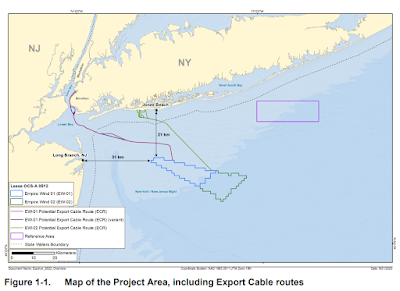Yes, you can navigate safely through a windfarm!
I was recently
invited to participate in an offshore wind simulator up in Middletown, Rhode
Island. Marine operations modeling and simulation.
The United
states maritime resource center (USMRI) is a not-for-profit 501C3 that is open
to all stakeholders, commercial, recreational fisherman, or anyone wishing to
experience this firsthand as
well as for US Coast guard training.
For the program, offshore wind developer Orsted’s Revolution wind farm was selected to
model. They used actual wind farm survey data, as well as manufacturing data to
create the towers, turbines, and related structures. The turbines themselves are
slated to be Siemens Gamesa 11 megawatt turbines atop a monopile tower and the
blades were about 95 feet off the sea surface. There were also substations
built into the model.
The turbines
are set up there at 1nm x 1nm, but please note that the wind farms further
south is to be set a bit closer at .08nm x 1nm. Additionally, they threw in a
few sailboats, Coast guard vessels and others to add obstacles and realism.
We had a
choice of vessels to operate, either an 80ft commercial fishing trawler or a 31
foot Contender center console recreational fishing vessel with twin outboards hanging
off the transom. Sea and weather conditions were changed on demand, and the
team and I got to experience pretty much everything they could throw at us,
high winds, big seas, rain, darkness fog, etc. The simulator was realistic
enough to make you seasick if you are prone to that. I noticed that my sea
legs actually kicked in and some others leaned against a wall or held onto
furniture! The floor in the room was stationary and it was your eyes and ears
that put you in motion and it was very realistic!
Regardless
of the conditions given it was clear to me that if you can’t navigate through a wind farm
, you don’t belong on a boat. Even under extreme conditions, I was able
to remain clearly out of collision range all the time. The navigation lights
and beacons on each tower were plainly visible. We were able to use the radar
system as well, and after a small bit of tweaking, each tower remained clearly
distinguishable just like any marker or buoy found at sea.
I would
really like to see one of these simulators built in Southern New Jersey so even
more mariners of all kinds could try it out, I hear there is another one down in Maryland
at the Maritime Institute of Technology & Graduate Studies (MITAGS)
facility. Overall,
it was a great learning experience that I highly recommend.








Comments
Post a Comment